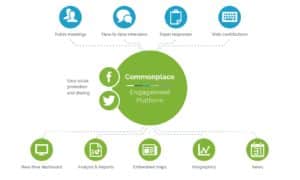For intimacy, banter and conviviality conventional wisdom leads us to the pub. I heard this argued with conviction recently, by the leader of a very large property firm. His ideal engagement consisted of a fraught loud meeting followed by a round of drinks down at The Local (which his company promises to keep open). The combination of testosterone and alcohol is made cosy: vent at the meeting, empathise with each other’s plight over a pint.
Cosy scenes may be as good for reputation as ale is for moods – but is a meeting and a round (who pays?) good public engagement? And, by extension, what are the trade-offs inherent in traditional engagement, and can we do better?
In reality, few people get to be heard at the public meeting. The maths are cruel: a well attended meeting will pack in 60 residents, and last at most 90 minutes. Allow 30 minutes for presentations and you have one minute on average for each participant to express their views. Recording the views that are articulated is sporadic at best; and the pub does not appeal to many people – even if they manage to arrange childcare to get to the meeting itself. Assessing how representative the views you manage to record really is often informed speculation at best.
Adding a digital platform can help. A digital platform will generally comprise of three main parts:
- A website that is accessible to the public. This will explain what the project you are consulting over is, and have an interface for users to respond to questions. The familiar SurveyMonkey is an simple example – essentially an online form.
- An underlying database that gathers and organises the data your users input.
- An administrators’ dashboard, through which you can access the data that has been gathered, and in some cases set up your survey.
The digital platform adds three major benefits to the more traditional consultation:
- Access – the availability of an online tool is not restricted by time or geography; and
- the data captured usually needs no further intervention, and is structured and hence easy to analyse and share.
- It gives you a presence in the social media – where your project may well be discussed already, too often without the benefit of factual information.
Realising these advantages depends on driving traffic to the digital tool that is being used. This is where social media comes to play, and with it a fortuitous demographic gain. Public meetings tend to attract citizens who are older and settled in their communities. Social media disproportionately is used by the young and mobile. Your digital platform, if used well, can both compliment the reach of traditional face-to-face activities, and create a single, accessible data repository.
So far so theoretical (even the round at the pub – sorry). What does a public engagement using a digital infrastructure look like?. Leading platforms would have a web platform with its database and administration functions at its core. In blue are the methods through which data can be entered. Each is supported by the core website in different ways – as you’d expect given their diverse characteristics:
- Web contributions: gathered directly into the website through a consultation questions interface.
- Paper responses: using paper forms, which are designed so that the questions match those for web contributions – leading to consistent data entry.
- Face-to-face interviews: uses the website on a portable device (tablet, usually) and the survey question are formatted differently – but feed into the same database for future analysis. Details of the interviewer are logged.
- Public meetings are the hardest. We recommend structuring them so that there is a specific “data capture” session, in groups. The audience can be divided according to specific interests – open spaces; provision for young people; transport etc. – and then invited to add their observations directly to the consultation using paper forms or tablets and phones.
The practice I have described is a far cry from a normal confrontational meeting and retiring to the pub. these too have their place, because venting and “feelgood” matter. But when it comes to serious, auditable and inclusive consultation, we can now set our ambitions higher.
David Janner-Klausner is Co-Founder of Commonplace Digital Ltd., which produces digital platforms for public engagement. Commonplace’s website is here, and David’s biography is on LinkedIn here.

